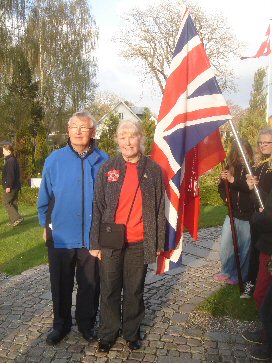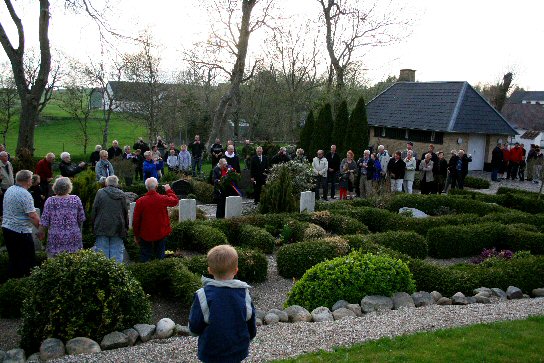 
Liberator
B 24 KH410
the crew
the wreath in 2013
Women
 She laid
a wreath on her father's grave - 66 years later She laid
a wreath on her father's grave - 66 years later
On the night between 20 and 21 April 1945 a
British Liberator B 24 bomber crashed in the Torstedlund Forest. The 11 crew
members on board were killed on the spot
and taken away by the Germans the next day. Nobody knew where the Germans
had taken them.
In the summer and autumn of 1945 a memorial was
erected at the crash site. The memorial, now called the Aviator Stone, was a big
granite boulder with an inscription carved by teacher Th. Johansen, Aarestrup. A
part of the undercarriage and one of the four propellers of the plane were
mounted on the reverse side of the boulder.
Most of the work was done by a team of workers from Nørlund Sawmill lead by
William Christensen, the driver of the sawmill.
The perished airmen were not found until the
middle of June 1947. They proved to have been dug down by Germans at the
crash site right after the crash. On 22
June 1947 they were buried in Aarestrup Churchyard in a magnificent ceremony
attended by 600 people. Residents of the area and people who had worked on the
memorial in the forest attended the ceremony together with Danish, Dutch and
British armed forces and a number of notabilities.
Vicar Harald Davidsen delivered a beautiful
funeral sermon with the words from the Norwegian poet
Nordahl Grieg as the
starting-point:
"The gave us the best they had, the dead unknown friends; they gave us a day to
use, reached with charred hands."
Before he officiated at the graveside ceremony
Vicar Davidsen finished his speech with the words, "Now we consign our unknown
friends to rest."
Only the Dutch Wilhelmina Guilonard, the widow of the captain of the plane
Nicodeme Guilonard, was present on behalf of the bereaved families. She was also
the only one who had been invited. The other bereaved families were not informed
that their loved ones had been found, and that they had been buried in Aarestrup
Churchyard, until long afterwards. Since then that treatment has triggered
bitterness among other surviving relatives such as the widow of the British rear
gunner Kenneth Emery and their daughter Ann who lost her father when she was 2½
years old.
In 1981 Ann, now with the surname Jordan, visited the churchyard in Aarestrup
together with her husband Colin and their three sons. By the merest chance they
happened to meet a couple of young Germans who told them that a memorial had
been erected at the crash site of the plane in the Torstedlund Forest. Together
they walked to the Aviator Stone which had been unknown to Ann until then. Later
during the visit they met Astrid and Aage Jensen who took Ann and her family to
the now ageing Vicar Harald Davidsen. In 1986 Ann and her family repeated the
visit in Aarestrup, where she met William Christensen and others.
In the summer of 2011 the
"Archive of Local
History of the former Municipality of Støvring" managed to get contact to Ann
Jordan. Since then much information has
been passed to mutual benefit between the Archive and Ann Jordan, who only knew
the circumstances of her father's death in incomplete and partly incoherent
parts.
In return the Archive was provided with invaluable information and
photos.
On that background Ann Jordan and her husband
Colin decided to go to Denmark in the days 8 to 11 May this year. As a
representative of the Archive Niels Nørgaard Nielsen gave them a guided tour of
all of the places related to events in 1945 and 1947 such as Aarestrup Churchyard and the crash site with the
Aviator Stone in the Torstedlund Forest.
Just by poking in the ground with a stick Ann here managed to find a number of
small parts of the wrecked plane. They also visited the place
where the coffins
with the deceased airmen had been placed between the finding in the forest and the
funeral on 22 June 1947, the remains of the German radar station
Lindwurm
in Fræer from which the plane very likely was observed when it entered the area,
and finally the spot near Juelstrup Vicarage from which Peter Hansen of Støvring very likely heard the plane coded N/206 in the air and shortly after saw the
enormous flash of light when the plane crashed and exploded in the forest some
kilometres
further to the south.
No doubt the culmination of the visit was
the memorial service in Aarestrup Church attended by some 130 people in the
evening of 9 May. The church was
beautifully decorated with new-leaved
branches of birch trees on every second row of chairs, and candles decorated with
ribbons in the British colours red, white and
blue on
the other rows. The service began when local scouts marched in with the British
Union Jack and the Danish
Dannebrog and went to the altar to the strains of
the
Prins Jørgens March
(The Prince of Denmark's March). Vicar Svend Schultz-Hansen delivered a
beautiful sermon dealing with the German occupation 1940 to
1945
and particularly the liberation in 1945 which was only possible because others made
an effort and many even lost their lives when fighting the nazi coercive rule.
As for
the parish of Aarestrup Schultz-Hansen particularly mentioned and thanked
Svend Otto Nielsen, a member of the resistance movement born in Aarestrup, who
was
executed on 27 April 1944, and the 11 airmen who perished in the crash in 1945
for their invaluable effort. The service was concluded with the song
A Lark
ascended
(En lærke letted') which for the first time ever was sung simultaneously in two
languages. As late as two days earlier Edward Broadbridge had translated
the
song into English to be used by British visitors.
After the service flowers were placed at the
memorial plaque to Svend Otto Nielsen in the porch and Ann Jordan laid the
wreath at the plot of the crew. As a special
feature of the wreathlaying ceremony this year she had been allowed to lay the
wreath with the red, white and blue flowers and ribbons on her own father's
grave.
All of
the previous years the wreath has been laid on Captain Guilonard's grave at the
centre of the row of graves. After the hymn Always dauntless the ceremony had
come
to an end. To Ann attending the ceremony was a kind of final funeral service to
the father nearly unknown to her. A number of invited guests then attended a
gathering in Aarestrup Vicarage where Ann Jordan had a chance to meet and talk
to a number of the people who had been involved in events back in 1945 and 1947
and a few that she had met during her earlier visits to Denmark. The event was a
great experience to Ann, and she thanks everyone who made this visit a warm and
lasting memory for her.
|

